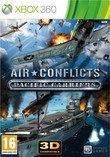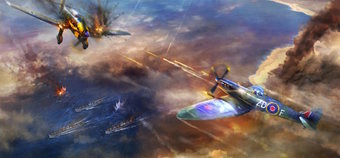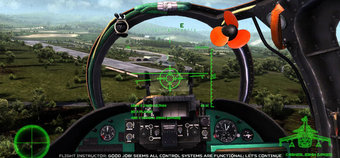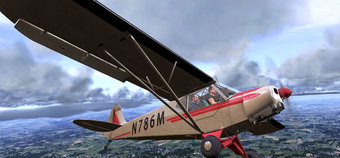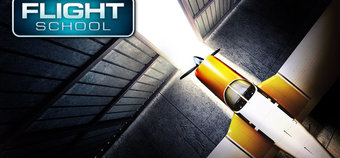There was a time when the flight sim was a rare beast, especially on a console - but for those of us who wake up in a flying jacket, sip our cereal through thick moustaches, and end every sentence with "what what, pip pip!" those days thankfully seem to be over. And while we're still trying to erase the disastrous Ace Combat: Assault Horizon from our memories, things have been a lot brighter so far this year, with the release of the hyper realistic Birds of Steel, a decent attempt at a Pacific flight sim, although with too much of an emphasis on online play, the arcade oriented Dogfight 1942, which made a co-op flight sim fun, and now, it's time to round off the year, with a look at Air Conflicts: Pacific Carriers, the latest in a now rejuvenated genre.
Much like Birds of Steel, Pacific Carriers is a WW2 flight sim set in the midst of the war between the Japanese and the US. Beginning, as you'd expect, with the surprise Japanese attack on the docked American fleet at Pearl Harbour, a strike which destroyed 188 aircraft, and cost 2,402 American lives. Coincidentally, the game also launched on the anniversary of Pearl Harbour - the 7th of December.
Split into two campaigns, you can take on the role of either the US or Japanese air force, as you play through a set of four campaigns that follow the events of the Pacific conflict. Taking in a variety of scenarios from the war, from Wake Island, to the Battle of Midway, the game make take a few liberties with its accuracy, but the campaign offer a nice variety of missions. It would be nice if the campaign took a bit more time to explain the historical significance around each of the missions, though - just so you know the back story behind each of the scenarios you're playing through.

Dive bombers, torpedo planes, fighters, level bombers - they're all here. And boats, too. Lots of boats.
If none of the above has meant anything to you yet though, there's no need to worry, as Air Conflicts: Pacific Carriers isn't as inaccessible as you may think. While Birds of Steel almost perfected the difficulty curve, letting you play on anything, from hyper "realistic" down to an arcade mode that took most of the worry of flying a plane away, leaving you free to worry about the important things - like shooting planes down -Pacific Carriers makes a valid attempt to do the same.
With a choice of two different control schemes, Arcade and Simulation (which are really more like realism settings) you can choose to tweak the game to your tastes. The Arcade difficulty, particularly, has been rather well done, in that it simplifies everything, but doesn't patronise you for doing so. You still have all the authenticity you'd expect from a flying game - you can take off and land on aircraft carriers, perform torpedo runs on ships, and dogfight with the best of them, without having to worry about stalling, running out of fuel, or anything else that would be classed as realistic. Even driving off the side of the aircraft carrier without getting up to speed won't kill you, making this a game that's great for novices taking their first steps. At the other end of the scale, though - well, things aren't quite as positive.
Playing on Simulation is meant to make things feel that little bit more authentic, granting you access to a few extra controls, and increasing the realism of the flight model. In reality, though, Simulation is almost exactly the same as playing on Arcade, only with an added effect that we'll call "Caffeine mode". You see, rather than flying (and shooting) in a straight line, all Simulation mode does is make your crosshair (and plane) wobble around the screen in a seemingly random manner, as though your pilot's had one too many coffees before taking off. Trying to attack a submarine becomes almost impossible - fly towards it, machine guns blazing, and rather than pumping it full of lead, you'll be surprised you don't see dozens of fish floating to the surface, as the random wibbling of your crosshair means you miss with 90% of your bullets. Realistic? Not really. Frustrating? Definitely. As a quick additional rant while we're here - on Arcade, you're not meant to be able to use your rudder (used to make fine adjustments left and right), while on realistic, you can. Allegedly. Unfortunately, in practice, the rudder makes no difference at all. Move the rudder left and right, and your plane won't respond at all, instead continuing to do its odd dance in the sky, crosshairs darting all over the place. It's disappointing to say the least.

Some of the battles happen on a rather large scale...
But back to the game. With four campaigns on offer, Pacific Carriers tries to do something a little bit different with its mission structure, in that there are a number of optional missions you can attempt as you progress through the campaign. Mostly divided into two categories, these see you either sitting watch on a ship, looking out for approaching enemy planes and/or ships, while the others send you on a patrol in the skies, as you use your radar to hunt out the enemy fleet, and send them to a watery grave. A nice change of pace from the action, it's a nice to see the game try something new.
Another new touch, but arguably one that doesn't work as well, is the experience system, which sees your pilots level up the more missions you take them on. The more missions they fly, the more things they shoot down/blow up, the better pilots they'll become. In reality, though, it doesn't really serve too much of a purpose - you don't tend to notice pilots levelling up (unless you're specifically trying for the one achievement/trophy), with the only time you actually realise anything's going on with your squad being when the game tells you if you've lost any pilots at the end of the mission...
On the whole though, Pacific Carriers is a lot of fun, and gets a lot of what makes these sort of games so enjoyable right. Torpedoing a ship is as challenging as you'd expect, as you have to get low, slow (take note, Birds of Steel), and aim well in front of your target if you're hoping to register a hit, although a handy on-screen graphic shows helps you line yourself up properly, while taking off and landing on aircraft carriers, performing bombing runs on enemy bases, and dogfighting are all a lot of fun. While there are some slightly iffy bits - dropping a bomb in the middle of a load of oil drums inexplicably fails to damage them - you'll have to get a direct hit if you're hoping to ignite them; having to choose your plane before the start of each mission isn't that well explained, which has led on a few occasions to us taking a heavy, slow torpedo bomber into a dogfight; while the cockpit view is rendered practically unusable thanks to an incredibly annoying high dynamic range lighting effect which completely blinds you (an incredibly oversight we'd have hoped they'd fix), Pacific Carriers is nonetheless a good companion piece to Birds of Steel. If you're after more of a single player game with less of a focus on authenticity, go for this - for us, Birds of Steel may still have the edge, but Pacific Carriers is well worth a look.
Format Reviewed: Xbox 360


